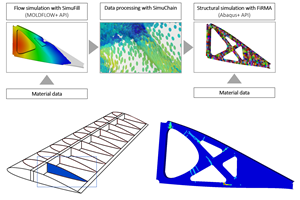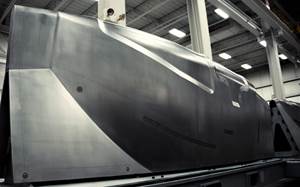Flexure test methods
The three fundamental mechanical property characterization tests of materials are tension, compression and shear. Note that flexure is not included. This article addresses some of the reasons why. When a beam resting on supports near its ends is loaded, the supported side is in tension and the opposite side is in
The three fundamental mechanical property characterization tests of materials are tension, compression and shear. Note that flexure is not included. This article addresses some of the reasons why.
When a beam resting on supports near its ends is loaded, the supported side is in tension and the opposite side is in compression. These induced bending stresses vary through the thickness of the beam. In addition, a shear stress is induced, which also varies through the thickness. All of these stresses also can vary along the length of the beam, with stress concentrations being introduced at the load and support points. As a further complication, the ratio of the magnitude of the normal (tensile and compressive) stresses to the shear stresses varies with the support span length-to-specimen thickness ratio of the particular beam geometry being tested. Definitely, the stress state in a beam is far from the uniform state desired for material characterization.
The question thus arises, "Why are flexure tests conducted?" One reason is that, if the flexural loading adequately simulates the actual loading conditions the material will be subjected to in service, such a test can be very meaningful. Too often, unfortunately, the reason the test is conducted is that it is simple to perform, and little consideration is given to whether or not it is meaningful.
There are currently two ASTM standards governing flexural testing, ASTM D 7901 and ASTM D 62722. A third is currently being drafted3. The first two are under the jurisdiction of ASTM Committee D-20-Plastics, while the draft standard is being prepared by ASTM Committee D-30-Composites. This leads to the next question, Why are three ASTM standards necessary?
ASTM D 790 has been in existence since 1970 and is well known. Until the late 1990s, this standard included both three- and four-point loading. But then Committee D-20 eliminated four-point loading from ASTM D 790, creating much concern among Committee D-30 members and the associated composite materials community, who routinely used this standard for both three-point and four-point loading. As a compromise, Committee D-20 then issued a new standard, ASTM D 6272, which included only four-point loading.
Committee D-30, to protect its future interests, decided to write its own standard, to include both three- and four-point loading. This effort was initiated approximately five years ago, and while the draft standard is still being revised and balloted, it appears, finally, to be nearing completion.
As noted above, both three- and four-point loadings are commonly used. This terminology, while universally used, can be a bit confusing. In both cases, the beam to be tested is simply supported near each end, the distance between these supports being termed the support span. The beam is then either loaded at mid-span (three-point loading) or at two positions equidistant from the two supports (four-point loading). While the distance of these two loading positions from the supports could be arbitrarily selected, as will be discussed, the corresponding ASTM documents specify the distance to be either one-fourth or one-third of the support span, referred to, respectively as quarter-point or third-point loading.
Fig. 1 indicates the three standard beam configurations. The loading magnitudes shown are those required to induce the same maximum bending moment in each beam.
When these configurations are compared, the significant parameters are the total loading applied to each configuration to achieve the same maximum bending moment in the beam, and the corresponding maximum local forces and maximum induced shear forces. These comparisons are shown in Table 1.
Note that to achieve an equal bending moment, twice as much total force must be applied to the quarter-point loaded beam, and 1.5 times as much to the third-point loaded beam. However, this is usually of little consequence in terms of testing machine capacity, since the required loadings are typically relatively low for flexural testing.
Of greater interest is the magnitude of the maximum local force, since this induces local stress concentrations in the beam and, possibly, degraded flexural strength. Third-point loading is the most favorable. Likewise, it is desirable to minimize the maximum shear force, to reduce the possibility of inducing unwanted shear failures in the beam, which would invalidate the flexure test results. Three-point loading is superior in this case.
One interesting extrapolation is that if the loading points are progressively moved even closer to the center of the beam, as they approach the limit (of becoming a single central force) the maximum local force and the maximum shear force both approach 1/2 P ("P" represents the applied load). That is, if the beam were loaded by two discrete forces near the center of the beam, the maximum local force would approach one-half that in the three-point loaded beam and the maximum shear force would be no higher than for three-point loading. This also suggests that three-point loading is also a favorable configuration, but that the central loading should be spread out to avoid high local stress concentrations.
One additional consideration should be noted. For three-point loading, the maximum bending moment occurs only at the center of the beam. For four-point loading, the bending moment is uniformly maximum between the loading points. That is, a greater volume of the beam is subjected to the maximum bending moment. But even this factor is tempered somewhat by the fact that the local stress concentrations can still make the loading point locations the critical sections.
Finally, the length of the beam must be selected. This is typically specified as the ratio of the support span length (s) to the beam thickness (t). The two existing ASTM standards recommend a ratio of 16:1 while the draft document specifies 32:1. However, since the induced shear stresses decrease relative to the bending moment as s/t increases, all three documents permit increasing this ratio if necessary to reduce shear effects, and all cite ratios of 16:1, 32:1, 40:1 and 60:1. Incidentally, the use of these specific ratios has no special significance, their selection being driven more by historical than technical considerations. Some guidelines for selecting an appropriate ratio are presented in the ASTM documents.
What then can be concluded from this discussion? Of the three standard loading configurations, three-point loading has definite advantages, particularly if the concentrated loading can be spread out a bit. One way to spread the loading is to use a larger loading radius. Currently both existing ASTM standards specify 5 mm (0.197 inch) radii, while the ASTM draft document specifies 3.2 mm (0.125 inch). The present discussion suggests that even larger radii would be beneficial in all cases.
References
1ASTM Standard D 790-03, "Test Methods for Flexural Properties of Unreinforced and Reinforced Plastics and Electrical Insulating Materials," ASTM International, W. Conshohocken, Pa. (first issued in 1970).
2ASTM Standard D 6272-02, "Test Method for Flexural Properties of Unreinforced and Reinforced Plastics and Electrical Insulating Materials by Four-Point Bending," ASTM International, W. Conshohocken, Pa. (first issued in 1998).
3ASTM Draft Standard, "Standard Test Methods for Flexural Properties of Fiber-Reinforced Polymer Matrix Composites," ASTM International, W. Conshohocken, Pa. (in preparation).
Related Content
Active core molding: A new way to make composite parts
Koridion expandable material is combined with induction-heated molds to make high-quality, complex-shaped parts in minutes with 40% less material and 90% less energy, unlocking new possibilities in design and production.
Read MoreImproving carbon fiber SMC simulation for aerospace parts
Simutence and Engenuity demonstrate a virtual process chain enabling evaluation of process-induced fiber orientations for improved structural simulation and failure load prediction of a composite wing rib.
Read MoreJeep all-composite roof receivers achieve steel performance at low mass
Ultrashort carbon fiber/PPA replaces steel on rooftop brackets to hold Jeep soft tops, hardtops.
Read MoreNine factors to consider when designing composites cure tooling
Gary Bond discusses the common pitfalls and compromises when designing good cure tooling and their holistic significance for a robust composite production process.
Read MoreRead Next
Developing bonded composite repair for ships, offshore units
Bureau Veritas and industry partners issue guidelines and pave the way for certification via StrengthBond Offshore project.
Read MoreVIDEO: High-volume processing for fiberglass components
Cannon Ergos, a company specializing in high-ton presses and equipment for composites fabrication and plastics processing, displayed automotive and industrial components at CAMX 2024.
Read MoreAll-recycled, needle-punched nonwoven CFRP slashes carbon footprint of Formula 2 seat
Dallara and Tenowo collaborate to produce a race-ready Formula 2 seat using recycled carbon fiber, reducing CO2 emissions by 97.5% compared to virgin materials.
Read More




















